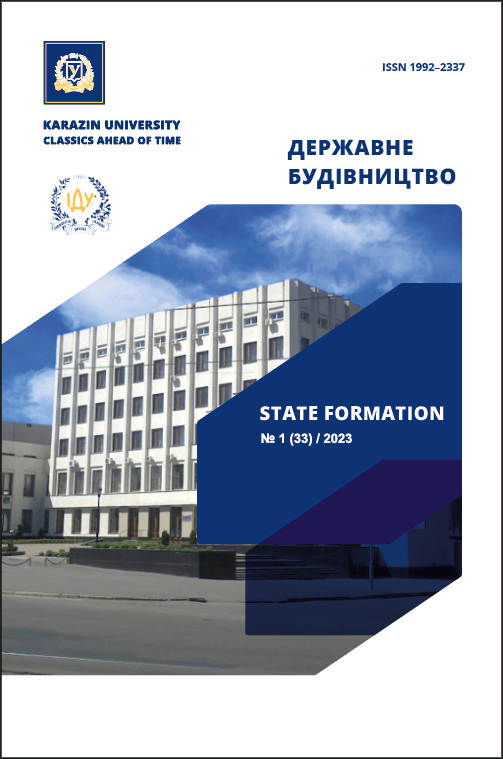GLOBAL MODELS OF STATE REGULATION OF THE BANKING SECTOR
Abstract
The study and systematization of foreign experience in the organization of the functioning of the banking system, the study of the role of the state in this process, the determination of the best practices that can be applied in Ukraine, is an actual direction of scientific research.
The main criterion for the classification of models of state regulation of the banking sector is the degree of state intervention in banking activity. Based on the analysis of research on approaches to the classification of models of state regulation of the banking sector and considering the most widespread practices in the countries of the world, it is proposed to distinguish liberal, European, American, mixed, transitional, and Islamic models of state regulation of the banking sector. The main characteristics of the models were systematized and the possibilities of their application in Ukraine were assessed.
It was determined that, considering the need to maintain stability and avoid risks, the European model is more appropriate for the conditions of Ukraine. An active role of the state in regulation can help prevent financial crises and ensure the reliability of banks. A mixed model, which allows combining elements of different models, can help create a flexible regulatory framework that considers the unique aspects of the Ukrainian economy and financial system. Under martial law, a transition model characterized by strong state intervention to stimulate development and financial inclusion is the most appropriate.
The study analyzed the degree of suitability of the proposed models in wartime conditions in terms of the priority tasks of the state regarding the regulation of the banking sector in wartime conditions, namely ensuring stability and reliability, efficiency, and flexibility, stimulating the economy and recovery, minimizing risks, and protecting the financial interests of citizens.
The theoretical justification of the role and functions of the central bank in the system of state regulation of the banking sector, as well as the development of mechanisms for increasing its efficiency in the conditions of martial law, may be the direction of further scientific research.
Downloads
References
Goyvanyuk M.P. (2011). International experience in the organization of systems of regulation and supervision of the activities of financial institutions. Problems and prospects of development of the banking system of Ukraine. Issue 32. P. 333-341.
Dyakonova I.I. (2007). State regulation of banking activity: study of models, justification of the categorical apparatus. URL: https://essuir.sumdu.edu.ua/bitstream-download/123456789/58777/6/D%e2%80%99iakonova_Derzhavne_rehuliuvannia_bankivskoi.pdf;jsessionid=5F6DB06141125838771E142C58FBCD6D
Naumenkova S., Mishchenko V. (2010). Regulatory systems of financial services markets of foreign countries: training. manual K.: Center for Scientific Research of the NBU: University of Banking of the NBU. 170 p.
Kovalenko M. M. (2015). The state and the banking sector: a realistic organization of interaction: a monograph. Kh.: Tim Publishing Group. 332 p.
Mekhtiev E.O. (2011). Use of foreign experience of state regulation of the banking sector in the process of adaptation to new operating conditions. Investments: practice and experience. No. 8. P. 54-56.
Moshensky S.Z. (2008). Models of state regulation of financial institutions. Finances of Ukraine. No. 6. P. 90-91.
Prysiazhniuk O.P. (2010). Models of state regulation of the banking system in the context of strengthening its financial stability. Information processing systems. Issue 3. P. 148-150. URL: http://nbuv.gov.ua/UJRN/soi_2010_3_70
About banks and banking activities. Law of Ukraine dated December 7, 2000 No. 2121-III https://zakon.rada.gov.ua/laws/show/2121-14#Text [in Ukrainian].
About the National Bank of Ukraine: Law of Ukraine dated May 20, 1999 No. 679-XIV. URL: https://zakon.rada.gov.ua/laws/show/679-14#Text [in Ukrainian].
Samsonov M. I. (2014). Trends in the development of banking supervision and regulation: international and national aspects. Financial and Credit Activity Problems of Theory and Practice. 1(12). URL: https://doi.org/10.18371/fcaptp.v1i12.28824
Surzhynskyi M. (2004). Concept and essence of banking regulation and banking supervision in Ukraine. Legal journal. No. 8. URL: http:// justiniancom.
Ustinova I., Poltoratska Yu. (2017). International practices of the organization of the banking system as a model for reforming banking supervision in Ukraine. Scientific works of the National Aviation University. Series: Legal Bulletin "Air and Space Law". K.: NAU. No. 1(42). P. 86-91 URL: https://er.nau.edu.ua
Tseluyko O.I. (2021). Peculiarities of state regulation of the banking system in the conditions of European integration. Law and public administration. No. 1. P. 262-270. DOI https://doi.org/10.32840/pdu.2021.1.39
Shcheglyuk M.S. (2015). Development of banking regulation and supervision in the conditions of European integration. Scientific Bulletin of the International Humanitarian University. URL: http://vestnik-ekonom.mgu.od.ua/journal/2015/13-2015/53.pdf
Burghof, Hans-Peter (1998). Eigenkapitalnormen in der Theorie der Finanzintermediation. Berlin: Duncker & Humblot. 331 s.
Vogel, Thomas (1990). Bankenregulierung. Die Zielsetzungen Einlegerschutz und Stabilitaet des Bankensystems. Wuerzburg, Julius-Maximilian-Universitaet. 245 s.

